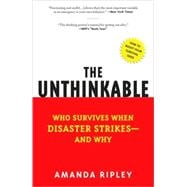
Note: Supplemental materials are not guaranteed with Rental or Used book purchases.
Purchase Benefits
What is included with this book?
| Introduction: "Life Becomes Like Molten Metal" | p. v |
| Denial | p. 1 |
| Delay: Procrastinating in Tower 1 | p. 3 |
| Risk: Gambling in New Orleans | p. 22 |
| Deliberation | p. 53 |
| Fear: The Body and Mind of a Hostage | p. 55 |
| Resilience: Staying Cool in Jerusalem | p. 85 |
| Groupthink: Role Playing at the Beverly Hills Supper Club Fire | p. 108 |
| The Decisive Moment | p. 139 |
| Panic: A Stampede on Holy Ground | p. 141 |
| Paralysis: Playing Dead in French Class | p. 163 |
| Heroism: A Suicide Attempt on the Potomac River | p. 179 |
| Conclusion: Making New Instincts | p. 203 |
| Author's Note | p. 225 |
| How to Boost Your Survival Odds | p. 229 |
| Notes | p. 233 |
| Selected Bibliography | p. 251 |
| Index | p. 259 |
| Table of Contents provided by Ingram. All Rights Reserved. |
The New copy of this book will include any supplemental materials advertised. Please check the title of the book to determine if it should include any access cards, study guides, lab manuals, CDs, etc.
The Used, Rental and eBook copies of this book are not guaranteed to include any supplemental materials. Typically, only the book itself is included. This is true even if the title states it includes any access cards, study guides, lab manuals, CDs, etc.
Excerpted from The Unthinkable: Who Survives When Disaster Strikes - and Why by Amanda Ripley
All rights reserved by the original copyright owners. Excerpts are provided for display purposes only and may not be reproduced, reprinted or distributed without the written permission of the publisher.